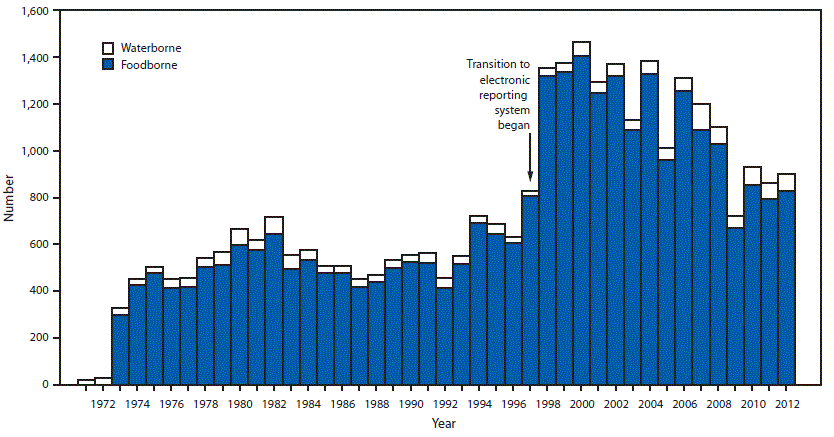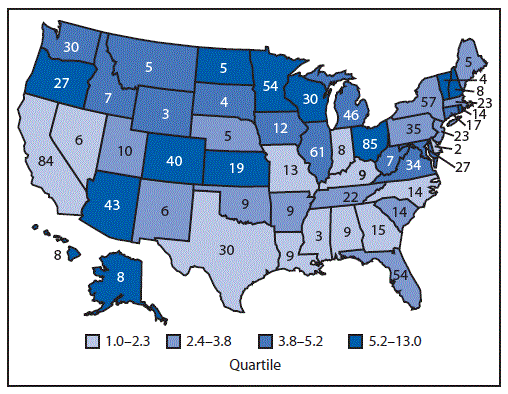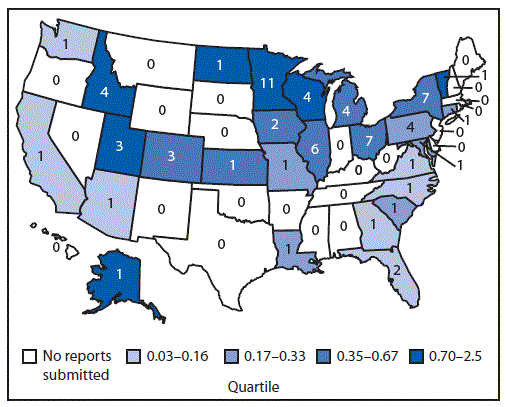Foodborne and Waterborne Disease Outbreaks — United States, 1971–2012
Corresponding author: L. Hannah Gould, Division of Foodborne, Waterborne, and Environmental Diseases, National Center for Emerging and Zoonotic Infectious Diseases, CDC. Telephone: 404-639-3315; e-mail: lgould@cdc.gov.
Preface
CDC collects data on foodborne and waterborne disease outbreaks reported by all U.S. states and territories through the Foodborne Disease Outbreak Surveillance System (FDOSS) and the Waterborne Disease and Outbreak Surveillance System (WBDOSS), respectively. These two systems are the primary source of national data describing the number of illnesses, hospitalizations, and deaths; etiologic agents; water source or implicated foods; settings of exposure; and other factors associated with recognized foodborne and waterborne disease outbreaks in the United States. This report summarizes data on foodborne disease outbreaks reported during 1973–2012 and waterborne disease outbreaks reported during 1971–2012. This report is a part of the first-ever Summary of Notifiable Noninfectious Conditions and Disease Outbreaks, which encompasses various surveillance years but is being published in 2015 (1). The Summary of Notifiable Noninfectious Conditions and Disease Outbreaks appears in the same volume of MMWR as the annual Summary of Notifiable Infectious Diseases (2).
Background
Foodborne Disease Outbreak Surveillance
Foodborne diseases cause an estimated 48 million illnesses each year in the United States, including 9.4 million caused by known pathogens (3,4). Only a minority of foodborne illnesses, hospitalizations, and deaths occur as part of recognized outbreaks (5). However, information gathered from foodborne disease outbreak surveillance provides valuable insights into the agents that cause foodborne illness, types of implicated foods and ingredients, and settings in which transmission occurs.
Foodborne disease outbreaks have been nationally notifiable since 2010; however, reports of foodborne disease outbreaks have been collected by CDC through FDOSS since 1973. Initially a paper-based system, FDOSS became web-based in 1998. In 2009, the system was transitioned to an enhanced reporting platform, the National Outbreak Reporting System (NORS), which also collects information on waterborne disease outbreaks and enteric disease outbreaks with modes of transmission other than food, including person-to-person contact, animal contact, and environmental contamination. Information about NORS is available at http://www.cdc.gov/nors.
Foodborne disease outbreak surveillance data highlight the etiologic agents, foods, and settings involved most often in outbreaks and can help to identify food commodities and preparation settings in which interventions might be most effective. Surveillance for foodborne disease outbreaks provides insight into the effectiveness of regulations and control measures, helps identify new and emerging pathogens, provides information regarding the food preparation and consumption settings where outbreaks occur, informs prevention and control measures in the food industry by identifying points of contamination, and can be used to describe trends in foodborne disease outbreaks over time.
Waterborne Disease Outbreak Surveillance
Despite advances in water management and sanitation, waterborne disease and outbreaks continue to occur in the United States. CDC collects data on waterborne disease outbreaks associated with drinking water, recreational water, and other water exposures through WBDOSS. Waterborne disease outbreaks have been nationally notifiable since 2010; however, reports of waterborne disease outbreaks have been collected by CDC since 1971. Initially utilizing a paper-based reporting process, the system transitioned to web-based reporting with the launch of NORS in 2009.
CDC uses waterborne disease outbreak surveillance data to identify the types of etiologic agents, settings, recreational water venues, and drinking water systems associated with waterborne disease outbreaks; inform regulations and public awareness activities to promote healthy swimming and safe drinking water; and establish public health priorities to improve prevention efforts, guidelines, and regulations at the local, state, and federal levels.
Data Sources
Foodborne Disease Outbreak Surveillance
State, local, and territorial health departments use a standard form (CDC form 52.13, available at http://www.cdc.gov/nors/pdf/NORS_CDC_5213.pdf) to report foodborne disease outbreaks to CDC. Data requested for each outbreak include reporting state; date of first illness onset; the number of illnesses, hospitalizations, and deaths; the etiology; the implicated food vehicle; the setting of food preparation and consumption; and contributing factors. Multistate outbreaks (i.e., those in which exposure to the implicated food occurred in more than one state) typically are reported to the system by CDC.
Only reports meeting the definition of a foodborne disease outbreak (i.e., the occurrence of two or more cases of a similar illness resulting from the ingestion of a common food) are included in this summary. Outbreaks that occurred on cruise ships and those involving food eaten outside the United States, even if the illness occurred in the United States, are not included in FDOSS.
Laboratory and clinical guidelines for confirming an etiology are specific to each bacterial, chemical/toxin, parasitic, and viral agent (http://www.cdc.gov/foodsafety/outbreaks/investigating-outbreaks/confirming_diagnosis.html). Suspected etiologies are those that do not meet the confirmation guidelines. The cause of an outbreak is categorized as "multiple etiologies" if more than one etiologic agent is reported.
Waterborne Disease Outbreak Surveillance
State, local, and territorial health departments use a standard form (CDC form 52.12, available at http://www.cdc.gov/nors/forms.html#waterborne) to report waterborne disease outbreaks to CDC. Data requested for each outbreak include reporting state; date of first illness onset; the number of illnesses, hospitalizations, and deaths; the etiology; the type of water exposure (e.g., recreational); the implicated venue or system, the setting of exposure; water quality indicators; and contributing factors.
Only reports meeting the definition of a waterborne disease outbreak (i.e., the occurrence of two or more cases of a similar illness resulting from exposure to a common water source) are included in this summary. WBDOSS includes reports of both gastrointestinal illness outbreaks and other illness outbreaks (e.g., legionellosis). Outbreaks that occurred on cruise ships and those in which the water exposure occurred outside the United States, even if the illness occurred in the United States, are not included in WBDOSS.
Interpreting Data
Outbreaks represent only a small fraction of the number of foodborne and waterborne illnesses reported each year. Outbreaks caused by certain pathogens or vehicles might be more likely to be recognized or investigated. However, some illnesses reported as sporadic likely are not recognized as being part of a reported outbreak or are part of undetected outbreaks. In addition, all outbreak-related illnesses might not be identified during an investigation, smaller outbreaks might not come to the attention of public health authorities, and some outbreaks might not be investigated or reported to CDC. Reporting practices for foodborne and waterborne disease outbreaks also vary among states, which might have differing definitions of which events are reportable and unique laws related to disease outbreak reporting. For these reasons, variations in reporting rates by state might reflect variations in levels of effort and funding for foodborne and waterborne disease outbreak investigation rather than actual differences in reporting rates by state. Finally, NORS maintains a dynamic database; this analysis included data on March 27, 2015 for foodborne disease outbreaks and April 27, 2015 for waterborne disease outbreaks. Results might differ from those published earlier or later.
Methods for Identifying Foodborne and Waterborne Disease Outbreaks
Guidance for states and jurisdictions for reporting foodborne and waterborne disease outbreaks is provided by CDC (http://www.cdc.gov/nors/forms.html). As for all notifiable conditions, reporting to CDC is voluntary, and state and local laws, regulations, and practices vary. For example, CDC advises states to report outbreaks with cases in the same household; however, state or local jurisdictions might determine that these outbreaks do not require investigation or might deem them nonreportable at the state level.
Publication Criteria
Foodborne disease outbreaks are defined as two or more cases of a similar illness resulting from ingestion of a common food. Waterborne disease outbreaks are defined as two or more cases of a similar illness linked epidemiologically by time and location to exposure to water or water-associated chemicals volatized into the air.
Highlights
Foodborne Disease Outbreaks
During 1973–2012, CDC received reports of 29,429 foodborne disease outbreaks with 729,020 outbreak-associated illnesses from 50 states, Puerto Rico, the District of Columbia, and freely associated states/territories. An average of 736 (range: 298–1404) outbreaks were reported each year (Figure 1). The average annual number of foodborne disease outbreaks reported to CDC during 1998–2012 was more than double the average annual number reported during 1973–1997, coinciding with the transition to an electronic reporting system.
In 2012, a total of 804 single-state exposure outbreaks were reported with 13,320 illnesses by 49 states and Puerto Rico (Table, Figure 2). An additional 25 multistate outbreaks (i.e., outbreaks in which exposure to the implicated food occurred in more than one state) with 1,496 associated illnesses were also reported.
More detailed annual summaries describing the implicated foods, etiologic agents, settings, and points of contamination associated with foodborne disease outbreaks are published periodically by CDC. A summary of foodborne disease outbreaks in 2013, the most recent year for which data are available, is available at http://www.cdc.gov/foodsafety/fdoss/data/annual-summaries/index.html.
Waterborne Disease Outbreaks
During 1971–2012, CDC received reports of 1,901 waterborne disease outbreaks with 639,949 outbreak-associated illnesses from 50 states and six freely associated states/territories. An average of 45 waterborne outbreaks were reported each year (Figure 1).
In 2012, a total of 73 outbreaks causing at least 1,261 illnesses occurred in 27 states and one territory. No multistate outbreaks were reported (Table, Figure 3).
CDC publishes separate and more detailed summaries of waterborne disease outbreaks associated with recreational water and waterborne disease outbreaks associated with drinking water. These summaries are available at http://www.cdc.gov/healthywater/surveillance/surveillance-reports.html.
References
- CDC. Summary of notifiable noninfectious conditions and disease outbreaks—United States. MMWR Morb Mortal Wkly Rep 2013;62(54).
- CDC. Summary of notifiable infectious diseases—United States. MMWR Morb Mortal Wkly Rep 2013;62(53).
- Scallan E, Hoekstra RM, Angulo FJ, et al. Foodborne illness acquired in the United States—major pathogens. Emerg Infect Dis 2011;17:7–15.
- Scallan E, Griffin PM, Angulo FJ, Tauxe RV, Hoekstra RM. Foodborne illness acquired in the United States—unspecified agents. Emerg Infect Dis 2011;17:16–22.
- CDC. Preliminary FoodNet data on the incidence of infection with pathogens transmitted commonly through food—10 states, 2009. MMWR Morb Mortal Wkly Rep 2010;59:418–22.
FIGURE 1. Number of foodborne and waterborne disease outbreaks reported, by year — United States 1971–2012

Alternate Text: The figure shows a bar graph displaying the number of foodborne and waterborne outbreaks reported in the United States during 1971–2012. The number of outbreaks varied by year with a general overall increase seen since the transition to an electronic reporting system began in 1997.
FIGURE 2. Rate* of reported foodborne disease outbreaks and number† of outbreaks, by state — Foodborne Disease Outbreak Surveillance System, United States, 2012

* Incidence of outbreaks per 1 million population based on the 2012 U.S census estimates. Cutpoints for outbreak rate categories determined by using quartiles.
† N = 829 (includes 25 multistate outbreaks assigned as an outbreak to each state involved).
Alternate Text The figure shows a map of the United States displaying the rate of reported foodborne disease outbreaks and the number of outbreaks in 2012. Rates and numbers varied by state. Data are drawn from the Foodborne Disease Outbreak Surveillance System.
FIGURE 3. Rate* of reported waterborne disease outbreaks and number† of outbreaks by state — Waterborne Disease and Outbreak Surveillance System, United States, 2012

* Incidence of outbreaks per 1 million population based on the 2012 U.S census estimates. Cutpoints for outbreak rate categories determined by using quartiles.
† N = 73.
Alternate Text: The figure shows a map of the United States displaying the rate of reported waterborne disease outbreaks and the number of outbreaks in 2012. Rates and numbers varied by state. Data are drawn from the Waterborne Disease Outbreak Surveillance System.
Use of trade names and commercial sources is for identification only and does not imply endorsement by the U.S. Department of
Health and Human Services.
References to non-CDC sites on the Internet are
provided as a service to MMWR readers and do not constitute or imply
endorsement of these organizations or their programs by CDC or the U.S.
Department of Health and Human Services. CDC is not responsible for the content
of pages found at these sites. URL addresses listed in MMWR were current as of
the date of publication.
All MMWR HTML versions of articles are electronic conversions from typeset documents.
This conversion might result in character translation or format errors in the HTML version.
Users are referred to the electronic PDF version (http://www.cdc.gov/mmwr)
and/or the original MMWR paper copy for printable versions of official text, figures, and tables.
An original paper copy of this issue can be obtained from the Superintendent of Documents, U.S.
Government Printing Office (GPO), Washington, DC 20402-9371;
telephone: (202) 512-1800. Contact GPO for current prices.
**Questions or messages regarding errors in formatting should be addressed to
mmwrq@cdc.gov.


